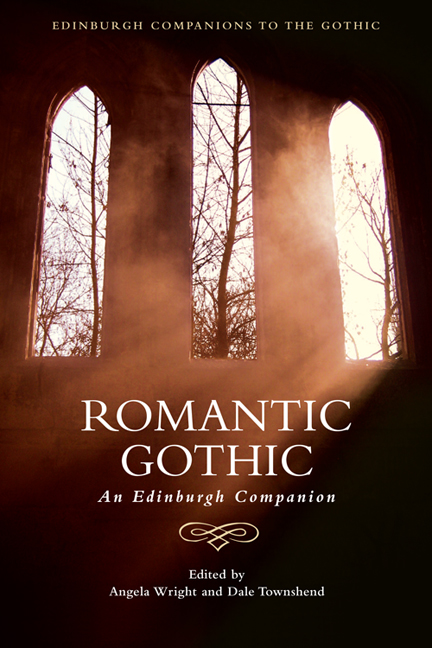Book contents
- Frontmatter
- Contents
- 1 Gothic and Romantic: An Historical Overview
- Part I Gothic Modes and Forms
- Part II National and International Borders
- Part III Reading the Romantic Gothic
- 15 Gothic and the Language of Terror
- 16 Gothic Science
- 17 Gender and Sexuality in Gothic Romanticism
- 18 Gothic Forms of Time: Architecture, Romanticism, Medievalism
- 19 Gothic Theology
- Notes on Contributors
- Index
17 - Gender and Sexuality in Gothic Romanticism
from Part III - Reading the Romantic Gothic
Published online by Cambridge University Press: 05 August 2016
- Frontmatter
- Contents
- 1 Gothic and Romantic: An Historical Overview
- Part I Gothic Modes and Forms
- Part II National and International Borders
- Part III Reading the Romantic Gothic
- 15 Gothic and the Language of Terror
- 16 Gothic Science
- 17 Gender and Sexuality in Gothic Romanticism
- 18 Gothic Forms of Time: Architecture, Romanticism, Medievalism
- 19 Gothic Theology
- Notes on Contributors
- Index
Summary
In Romanticism and the Painful Pleasures of Modern Life (2008), Andrea K. Henderson has described the mainstream of Romantic aesthetics as riven by fascinations with ‘suspenseful, idealizing, and self-abnegating desire’ for pain and submission (Henderson 2008: 6). Seeing in this tendency not only a proto-Masochistic claim that ‘the keenest pleasures are allied to pain’ (Henderson 2008: 7), but also a tension between the desires for domination and the powerful democratic and even radical claims that many of the Romantics advanced, Henderson asks, ‘how is it that a body of literature renowned for its articulation of new ideologies of equality could also be characterized by a fascination with willing submission?’ (Henderson 2008: 2), before arguing that ‘In essence, much Romantic-era writing aestheticizes one of the primary contradictions of industrial culture, recasting it in the form of a thrilling, if also painful, private psychodrama’ (Henderson 2008: 3).
For Henderson, this apparent paradox emerges from the social ruptures of a new credit economy: ‘Artists such as Hogarth, Joseph Addison, and Daniel Defoe claimed that finance capitalism taught men to revel in suspense and emotional extremes, and to take new pleasure in a powerful and independent female sexuality. Thus did the gendered metaphors of political rhetoric become a potent means for understanding modern sexuality’ (Henderson 2008: 46). Without challenging the economic grounding of her readings, I would argue that what Henderson has uncovered is the striking interdependence of the strands of Gothic and Romanticism in the early nineteenth-century articulation of a theory and politics of gender and sexuality. Indeed, we can see in the terms of Henderson's analysis of Romantic production a rhetorically Gothic shadow, not only in the reference to ‘the dangers of desire’ (Henderson 2008: 3) and ‘pleasure in pain’ (Henderson 2008: 7), but also in her observation that this self-consciously modern group of artists and theorists frequently relied on the aesthetics and settings of an anachronistic medievalism: for Romantic-era literature, she points out, ‘Medieval romance provided a highly suitable template for representing and rendering aesthetic the affective challenges of modern society’ (Henderson 2008: 5).
This is the same medievalism (or false medievalism) with which Jerrold E. Hogle has opened his account of the rise of Gothic fiction in England: ‘Gothic fiction’, he observes, ‘is hardly “Gothic” at all.
- Type
- Chapter
- Information
- Romantic GothicAn Edinburgh Companion, pp. 322 - 338Publisher: Edinburgh University PressPrint publication year: 2015



